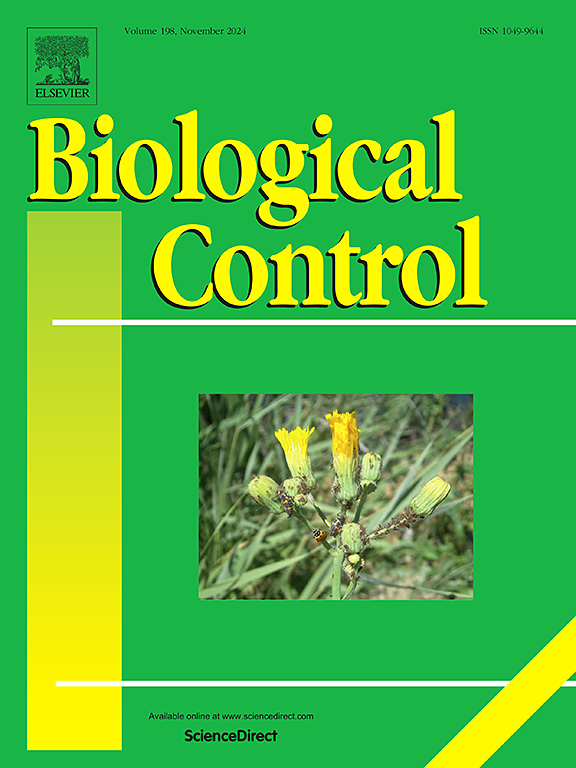森林保护生物防治:以松林行军蛾为例
IF 3.7
2区 农林科学
Q2 BIOTECHNOLOGY & APPLIED MICROBIOLOGY
引用次数: 0
摘要
在森林生态系统中,由于全球变化,虫害对树木造成的损害正在增加。传统的生物防治已被证明是有效的控制外来害虫,通过引入害虫本地范围的天敌。然而,对于本地害虫,以改善本地天敌的栖息地和资源为目标的保护性生物防治更为合适。虽然在农业系统中进行了广泛的研究,但这种方法很少在森林中进行试验。在本研究中,我们旨在测试阔叶篱墙是否可以通过为食虫鸟类大山雀(Parus major)提供有利的栖息地来改善邻近松林中松树迁徙蛾(Thaumetopoea pityocampa)的控制。为此,我们评估了与阔叶树篱或成熟松林相邻的松林边缘的PPM侵染情况,用录音机记录了大山雀的声音活动,并用模拟毛虫实验测量了鸟类的捕食情况。邻近树篱的松林边缘幼虫巢密度低于邻近成熟松林边缘幼虫巢密度。我们发现鸟类在靠近树篱的松树边缘更频繁地捕食。鸟类的捕食也与大山雀的发声活动呈正相关,大山雀是冬季松林毛虫的主要捕食者。在单一针叶林中,阔叶植物篱不仅有助于控制害虫,而且可以促进生物多样性,保护松林免受非生物危害,从而增强人工林景观的多功能性。本文章由计算机程序翻译,如有差异,请以英文原文为准。
Conservation biological control in forest: A case study with the pine processionary moth
In forest ecosystems, the damage caused to trees by insect pests is increasing as a result of global change. Classical biological control has proven effective in managing exotic pests by introducing natural enemies from the pest’s native range. For native pests, however, conservation biological control, which aims to improve the habitats and resources for native natural enemies, is more appropriate. While widely studied in agricultural systems, this method has been rarely, if ever, tested in forest. In this study, we aimed to test whether broadleaved hedgerows could improve the control of the pine processionary moth (Thaumetopoea pityocampa) in adjacent pine stands by providing a favorable habitat for an insectivorous bird, the great tit (Parus major). To this end, we assessed PPM infestations on the edges of pine plantations adjacent to broadleaved hedgerows or mature pine plantation, recorded the vocal activity of great tit using sound recorders, and experimentally measured bird predation using dummy caterpillars. The density of processionary caterpillar nests was lower at the edge of pine stands adjacent to hedgerows than at the edge adjacent to mature pine stands. We showed that bird predation was more frequent on pine edges adjacent to hedgerows. Predation by birds was also positively correlated with the vocal activity of the great tit, the main predator of pine processionary caterpillars in winter. In conifer monocultures, broadleaved hedgerows not only help to control the pest but could also promote biodiversity and protect pine plantations from abiotic hazards, thereby enhancing the multifunctionality of plantation landscapes.
求助全文
通过发布文献求助,成功后即可免费获取论文全文。
去求助
来源期刊

Biological Control
生物-昆虫学
CiteScore
7.40
自引率
7.10%
发文量
220
审稿时长
63 days
期刊介绍:
Biological control is an environmentally sound and effective means of reducing or mitigating pests and pest effects through the use of natural enemies. The aim of Biological Control is to promote this science and technology through publication of original research articles and reviews of research and theory. The journal devotes a section to reports on biotechnologies dealing with the elucidation and use of genes or gene products for the enhancement of biological control agents.
The journal encompasses biological control of viral, microbial, nematode, insect, mite, weed, and vertebrate pests in agriculture, aquatic, forest, natural resource, stored product, and urban environments. Biological control of arthropod pests of human and domestic animals is also included. Ecological, molecular, and biotechnological approaches to the understanding of biological control are welcome.
 求助内容:
求助内容: 应助结果提醒方式:
应助结果提醒方式:


